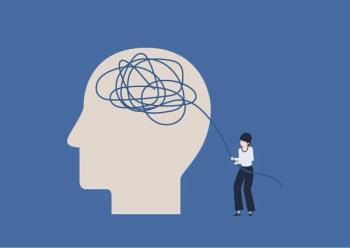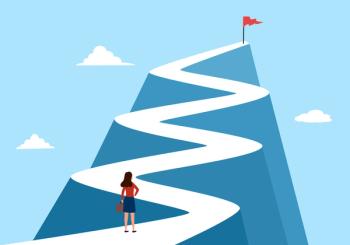
The Three Line Model of Mental Health
Learn how to use this simple heuristic model, which illustrates both the interplay of social (historical and current), psychological, and biological factors in the development of psychopathology.
Need instructions for how to make a Three Line Model? Learn how to
With ever-growing excitement around biological rationale and treatments of psychopathology, and ever-present advertisements for such rationale and treatments, patients often arrive at a prescriber’s office hopeful for a purely biological solution to their mental health struggles. As prescribers, we are aware of the benefits and the limitations of medication. In many cases the best practice is not to increase, add, or even consider medications; however, depending on the way this is presented, patients may hear our hesitation as dismissal, mistrust, or withholding, at times leading to lost rapport, or in more extreme cases to arguments or potentially violence.
Consider a few common examples:
-A patient presents following the death of a loved one, seeking an increase in medication.
-A patient with anxiety adamantly requests
-A patient with intellectual disabilities has outbursts, and changes to medication are being requested despite lack of clear effort being made by caregivers to understand patient triggers or nonverbal cues.
-A patient with a clear
In each of these cases, the medication requested may not be appropriate at all. If it is, it is likely not more than a small part of the complete treatment plan. However, patients are often reluctant to collaborate once they have internalized the denial of their request as outright rejection.
As I considered ways to discuss these difficult medical decisions, I developed this model, which has been extraordinarily helpful as a way of explaining appropriate medication use in the context of the larger biopsychosocial picture, without compromising the therapeutic alliance. Having a clear, understandable route toward improved mental health has empowered many of my patients to make important changes in their lives, appropriately utilize psychotherapy, and decrease overall reliance on biological interventions.
The Three Line Model of Mental Health
Disclaimer: While review of research shows support for the statements that follow, this model is meant as a heuristic device, not as a paradigm of psychopathology.
Colors were chosen arbitrarily, but colors strongly associated with emotion, such as red or blue, were purposefully avoided. The colors are useful in discussion as a means of orienting quickly to the pertinent portion of the model. It is typically most helpful to discuss this model after completing the history taking portion of an appointment, as an introduction to the plan.
In discussing this model with patients, it has been of most benefit to start with the bottom and work up; in discussing interventions, it is best to start from the top and work down. This article is organized like the model is generally presented.
Discussion of Pathology
Personal or Baseline Stress (Purple Line)
This line, which sits at the bottom of the model, represents the baseline level of stress in a person’s life. This is the level of stress present regardless of what happens from moment to moment and is mostly static, though it does change over time with life circumstances. Items that contribute to the stress baseline include:
-Financial situation
-Housing situation
-Work situation
-Familial responsibilities
-Medical problems
-Relationships with family and friends
-Presence or absence of hobbies or social engagement
-Threats to safety
-Adverse childhood experiences1
-Past trauma
-Grief
In general, there are 2 sets of factors here, those directly related to current life situation, and those that accumulate over time.
Psychosocial or Moment-to-Moment Stress (Green Line)
The green line represents moment-to-moment happenings (line curving upwards), and the response of a person’s mind to these (rise and peak of each bump). Examples include:
-Things heard or seen from others
-Things heard or seen in the environment
-Thoughts that arise in the mind
-Reminders of trauma
-Impending events or responsibilities
Here it is simply noted that there is continuous fluctuation, where the height of each bump depends on the level of response each input elicits from the mind. The significance will be presented momentarily.
Genetic Susceptibility, or the Threshold (Orange Line)
The orange line could be described as “the genetic piece of mental health.” Some have called it genetic susceptibility or innate
Psychopathology
When individuals present with mental health concerns, the hypothetical graph generally looks something like
When the green line (moment-to moment stress) crosses the orange line (threshold), symptoms of mental illness arise, from racing thoughts and loss of focus to anhedonia, feelings of guilt, and suicidal thinking, or from paranoia and intense auditory hallucinations to urges for
Life situation and personal history, the mind’s reaction to internal and external stimuli, and a genetic threshold all contribute to both psychiatric health and illness.
Treatment of Psychopathology
The previous section is a preamble to the most useful aspect of this model, which is to aid in discussing treatment. Thankfully, the same lines that help a patient understand the aspects of their pathology help explain what can be done to effectively intervene.
Biological Interventions (Orange Line)
While specific mechanisms of action vary, the general effect of biological interventions in mental health, including medication, electroconvulsive therapy,
The goal of medication is to lift the threshold, leading to fewer inputs crossing it. If there are fewer crossings, it follows logically that there are fewer symptoms: fewer panic attacks, nightmares, flashbacks, guilt-filled thoughts, suicidal thoughts, auditory hallucinations, manic episodes, distractions, etc.
Medications do not, however, alter the other lines of the model. This intuitively makes sense, as medication is not going to change a patient’s life situation, or the way life experiences have taught patients to respond to the things happening around them. When medication is “not working,” often the best approach is not to increase doses or add adjunctive medications, but to shift focus to nonpharmacologic measures.
It is worth discussing a caveat here. There are many whose lives change drastically with medication and no other intervention. In such cases, it is possible that the threshold has lifted enough (few enough inputs are crossing) that a patient is in a position to do their own in vivo exposure, prepare for and attenuate their own responses to moment-to-moment stresses (green line), do their own emotional processing and exploration, or make helpful changes to their own life situations (purple line).
Psychological Interventions (Green Line, Purple Line)
There are myriad psychotherapeutic interventions addressing the spectrum of mental illness. In general, the effect of any of these interventions is either to lower the amplitude of the mind’s response to psychosocial stresses (green line), or to address factors contributing to persistent personal stress (purple line) (
Intervention Examples
Grounding: One very useful idea in discussing grounding with patients is Daniel Siegel, MD’s Hand Model of the Brain.
The gist of this model is that energy can travel from our emotional brain centers to both the brain stem (fight, flight, or freeze) and to the cortex (thinking, reasoning, seeing, etc). When hit by a strong emotion, the emotional centers tend to shunt energy away from the cortex and to the brain stem, leading to reactive fight-or-flight responses. By consciously forcing the cortex to be active in any way, such as thinking about and labeling a feeling, noticing things in the environment with the senses, holding a piece of ice, or any other grounding technique, some portion of that fight-or flight energy is sent to the cortex, leaving less energy for the fight-or-flight response. This allows for a more appropriate response to an appropriate feeling. When practicing such techniques, patients learn that their strong emotions are often, in fact, a sign of mental health rather than of mental illness.
Meditation: Practicing meditation is another way to train the brain to respond to stressful situations. There are many forms of meditation, which develop the ability to draw attention to and maintain focus on a particular stimulus, often within the individual. The idea alone of drawing focus to something rather than away from something can be helpful.
Extinction: One of the clearest examples of working with the mind’s reaction to moment-to moment stress (green line) is exposure therapy, wherein a patient is asked to tolerate a strong negative emotion (the green line’s peak) until the emotion starts to calm. With repeated exposure, patients find that the peak lowers over time, and many things that were once feared become less bothersome. This is the basis for therapies such as prolonged exposure for
Any number of therapy modalities and techniques fit nicely here. In summary, there are ways to prepare for and attenuate the response to psychosocial stressors, leading to fewer or to less intense threshold (orange line) crossings.
Social Interventions (Purple Line)
The purple line represents baseline stress, which is largely the product of a person’s current life situation and their history. Matters of past trauma and unresolved interpersonal conflicts contribute greatly when present.
Social interventions seek to make changes to a person’s life situation, with the goal of lowering their stress baseline, as in
Efforts in psychotherapy that affect the stress baseline include processing trauma, grief, and adverse childhood experiences, repairing strained relationships, and setting more effective interpersonal boundaries. Developing hobbies and pursuing appropriate social activities also apply, which are largely the basis of behavioral activation, or the behavioral piece of cognitive behavioral therapy.
Discussion
The Three Line Model stands to be useful tool in psychoeducation for several reasons:
- It provides context for a patient’s mental health concerns. The author has yet to meet a patient that did not resonate with the layout and explanation.
- It provides a framework for treatment, which empowers patients to take an active role in their journey toward improved mental health.
- It is flexible and adaptable to nearly any mental health condition. The main difference is which symptoms appear when the threshold (orange line) is crossed. This agrees with research that suggests even in conditions thought to have a stronger biological component, such as
- It gives a reasonable expectation of medication’s effect. Many patients come in with problems seated firmly in the personal (purple) and psychosocial (green) areas, hoping that medication will somehow fix their situation. While medication has a role in treatment, this tool helps patients grasp the limitations of medication’s benefit, which in turn may decrease the pressure to pursue ineffective off-label treatments and unnecessary polypharmacy.
- For patients who fear, who do not understand, or who are not interested in psychotherapy, it demystifies the psychotherapy experience and gives them an idea of what therapy is meant to accomplish. As many patients are unsure how talking to someone will help, this may open patients’ minds to both short interventions in follow-up appointments with primary care and psychiatry, as well as set them up for success in more dedicated psychotherapy efforts.
- Of note, in some cases, as a result of having a very low threshold (orange line), an abundance of personal stress (purple line), particularly adverse childhood experiences, or a combination of the 2, the graph may be best described as having the baseline (purple line) above the threshold (orange line). This does not change the previous discussion, except that medication may be felt to be a more necessary first step prior to psychological and social interventions.
Concluding Thoughts
My goal in writing this is to share a model that I have found simple, intuitive, useful, and versatile, and that, by its explanation, has empowered many of my patients in their course toward improved mental health. I hope that those practitioners who are open to the idea find a similar benefit.
Dr Stockton is a psychiatrist in Milwaukee, Wisconsin.
The author wishes to acknowledge the following for their support and encouragement: Flora Agyei, APNP; Steven Graybar, PhD; Ellsworth Lewis, PhD; Basil Jackson, MD; Jennifer Carrasco, PhD; and Robert Stockton.
References
1. Felitti VJ, Anda RF, Nordenberg D, et al.
2. Dr. Dan Siegel’s hand model of the brain. Dr Dan Siegel. 2020.
3. Brus M, Novakovic V, Friedberg A.
Newsletter
Receive trusted psychiatric news, expert analysis, and clinical insights — subscribe today to support your practice and your patients.














